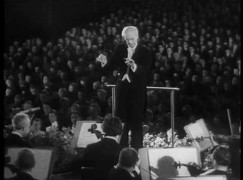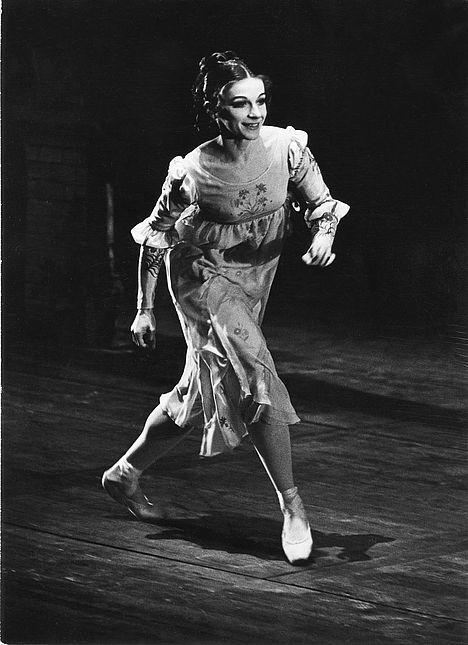The Met can’t get its new Carmen on stage
OperaWe hear there’s trouble backstage at the Metropolitan Opera with putting up sets for the year-end premiere of a new production of Bizet’s Carmen.
The scenery was made at Bay Productions in Cardiff.
Apparently it was not strong enough to support a 12,000-pound truck which threatened to crush the set.
The Met crew downed tools and the set was shipped to a non-union shop in Wayne, New Jersey, for reinforcements. It came back, still hazardous. The Met crew are working all hours to save it.
Folk are asking Peter Gelb if it wouldn’t have been cheaper to make the set in-house.






Was the original spec correct?
Presumably not.
The Met should have used a cart – then they could put it before the horse.
What a catastrophe! Will the MET and the New York culture scene ever recover from this major c**kup? Peter Gelb must be hauled through Lincoln Sq to answer for this. Or so some who should know better would like to happen.
OH MY GOODNESS!!!!
Get over yourself
Relax
…..actually, just let the grownups talk
I do believe Cynical Bystander was being facetious. (You really didn’t get that??)
Surprise, surprise…
Just wouldn’t be Carmen without a six ton truck!
Considering the history of having to reinforce the subfloor of the Met’s stage for the enormous weight of the now-retired “machine” staging of Wagner’s “Ring,” I find myself unable to be surprised by this new “Carmen” situation.
I wish I could go this opera this year, but I have zero interest in seeing and listening to Carmen in a 6-ton truck. So I won’t pay for it. What will Jose do? Walk with wrenches, change oil and pump tires?
Well said, I couldn’t agree more!
Well the Médée at Berlin Staatsoper had a missile launcher truck, and I wouldn’t have missed that for anything in the world. Sometimes it’s worth seeing beyond the truck.
I guess, but then why have a truck on stage in order to look beyond the truck?
Volpe would have known better…
You are not alone.
Volpe started in stage crew and worked his way up, so he knew the equipment and limitations of the stage, even referring to Zefferelli as a whacko while trying to fix the scenic disaster that was Antony and Cleopatra.
Yes, we all know Joe’s origins, but more importantly, he proved to be an extremely good general manager, understanding that his job encompassed all areas of the theater, from the box office to the stage. Sadly, the current mess picks and choses what he is interested in (being a master of none) and as a result, the company is failing.
Wouldn’t the set have been teched on stage back in August, pre-season??
Opera today needs fewer hard surfaces (to suit the camera, i.e. for filming) and more flat scenography (so that scenes can change when they should, and more often) to please the seated theatre audience.
The hard surfaces are costly, bulky, heavy (as in this Carmen), awkward to store, much less likely to present a moving story, and intrinsically of the TV studio not the theatre. Composers and librettists never had them in mind.
What was wrong with the previous production?
It wasn’t woke enough, evidently.
or Eurotrash
It likely had been seen for more than 50 performances (not having checked the stats), as productions are generally designed with that depreciation rate in mind. A popular opera can run to that number in 4-5 years of scheduling.
Is that Carmen driving a truck in the photo? I hope this is not another modern update like Lucia di Lammemoor with blood on the walls.
It is.
It’s actually worse than that!
And when they do, it will be epic and bland like. everything Gelb’s timid taste allows. No one with taste cares about the Met. Next.
The MET’s attention to sets & costumes really pays off, IMO.
Just saw Florencia en el Amazonas & it was breathtaking visually. The sets were simple, but effective & very creative, the costumes stunning and the clever depictions of tropical animals, fish & birds were a highlight of the opera! Imagine a school of piranhas as dancers in red ballgowns wearing golden fish heads or a powerful heron played by a very tall male dancer with long legs swooping around onstage. Plus puppeteers with monkey & iguana puppets that nearly stole the show!
The vocal artistry, of course was wonderful & highlighted some of the finest Spanish speaking singers we have today. Daniel Catan’s music is gorgeous & so well suited to opera.
The extra effort Gelb & co. put into major details like sets & visual appeal, to me is very important. So if he wants to bring in a set from Cardiff, more power to him! I’m sure the result will be spectacular.
I don’t care where Gelb gets his sets so long as they don’t cost $20 million and do fit onto the Met stage without crashing into the basement. And please, no tanks or Nazi uniforms.
Disgusting.
Bing is turning over in his grave!!
Or maybe just commission a decent production
Nearly 70 years since Carmen Jones and US operagoers are still losing their shit over the idea of a production that doesn’t feature flamenco skirts and orange trees. The idea that NY is a major international centre of opera in anything more than a purely financial sense has been a bad joke for several decades now. Incredible that such a large city should be so provincial.
That kind of conservaduirism is a form of philistinism.
If companies don’t try new things they become irrelevant, the Met is expanding the repertoire and taking risks that work, don’t work or face indifference, but they don’t have the luxury of staying still, specially now that one can watch productions from all over the world at the push of a button.
As they say in England to make an omelette your have to break the eggs first.
Ah, yes. England. The land of innovation.
A truck as the raison d’être of Prosper Mérimée’s novella?
Does this mean Carrie Cracknell sees Lillas Pastia as head of the Teamsters?
Given the inapposite automotive focus of the production, if the Yellow Man had any sense of clever corporate funding, he would have asked Volkswagen to sponsor the production as a retro tribute to the classic Karmann Ghia.
The term “truck” in theatrical parlance doesn’t mean an on-road vehicle piloted by a teamster. Rather, it’s a movable platform that can be used to bring pre-set scenic elements on and off the stage quickly and quietly. The Met couldn’t exist without stage trucks to perform scene changes quickly and quietly, in a house that mounts a different opera every night (twice on Saturdays). If there’s a problem with this Cardiff-built truck for “Carmen,” it’s not comparable with the LePage “machine” for the Ring, which was uniquely heavy and noisy.
Wouldn’t such “trucks” already be part of the Met’s stage equipment, designed to fit precisely within the stage lifts?
In any case, it says that the scenery wasn’t strong enough to support the truck, not the other way around.
Stephen Owades is correct in his explanation of the stage management understanding of the word “truck”.
However in this case, as evidenced by pre-performance production photos and set design sketches, the truck in question is indisputably something off the assembly line of MAN or Scania motor works.
While such a camion novelty may create momentary visual titillation akin to Barrie Kosky’s clown car in his recent Bayreuth Tannhäuser, it essentially confirms the caveat that directors of drama, no matter how capable or even celebrated, do not automatically succeed when let loose on the operatic stage.
Bring back the Zefferelli!! It was the production that convinced me to like opera when I was in my 20s in 2006. We don’t have to do ugly updated productions to get young people interested.
2006 called and it want its comment back.
Sorry, times have changed. Old-school opera fans need to move on.
New-school opera fans seem to be rather short in supply.
Gosh, that was a production that sucked life out of the piece.
The Zefirelli was overblown. If the designs still exist, it’s time to rebuild and revive the 1951 Tyrone Guthrie production.
The Zefferilli Carmen was a disaster. Not one of his better efforts.
Why? I believe I saw it at city opera and it was gorgeous. Gleaming white stucco for eons.
Zefferilli never designed nor directed any production for NY City Opera.
Opera has a major image problem.
People harping back decades aren’t going to change that.
Sorry I spelled his name wrong: Zeffirelli
Didn’t you also claim the Tannhauser sets were covered in black mold and needed a lengthy cleaning, meanwhile they went on stage without a hitch days after your reporting.
Gelb is a menace to opera and the Metropolitan. Bing, Gatti-Cazazza. and Joe Volpe are spinning in their graves. Time for Gelb to go.
Joseph Volpe is still alive, you know?
And we can use him; in fact, we should beg him to come back.
Volpe isn’t spinning at all. He’s currently the Executive Director of the very successful Sarasota Ballet….
I believe Mr. Volpe is still very much alive.
Why is there a 12,000lb truck being used in the opera Carmen? Carmen is set in the days of horse or mule transport . I suspect some modern reinterpreted version of Carmen.
Yeah, but we live in the 21st century, it is perfectly legitimate to look for new scenarios around the same music and topics.
The original scenario is truly archaic for many reasons and may attract fewer people in a city with Broadway within walking distance.
Not only that, but the theater is using electricity to light the opera. Come to think of it, some of the performers were born in the 20th and even 21st centuries. I don’t get how I am supposed to overlook those facts.
Carmen – that’s the opera that sets unique challenges, surely. How to deal with the bullfighting? Bullfighting – the degrading spectacle with artistic pretensions and grotesquely inflated claims regarding the courage of the bullfighters.
As a reminder of what these people get up to and what the people in a bullfighting audience pay to see (the form of bullfighting where the bull is killed, popular in Southern France as well as Spain), you could do worse than watch some extracts from this You Tube video
https://www.youtube.com/watch?v=OWXwC4BHfk8&ab_channel=Cte.Mart%C3%ADn
At 1:35:33 the bull is stabbed. The sword is embedded deeply in the bull but the bull is very much alive. Only at 1:38:29 does the bull die.
Another bull, another attempt at killing: 2:14:52, the matador takes aim with the sword. It takes a long time to kill this bull too.
Long drawn out attempts to kill are absolutely commonplace. Every bull is stabbed a minimum of eight times, once with the lance of the picador, six times with the banderillas and once with the killing sword but it’s common for the number of stabbings to be much higher, as many as 25 or more.
Bad as bullfighting is now, it was far worse at the time when Carmen was written. Then, the horses of the picadors were completely unprotected. Every bullfight arena was littered with disembowelled horses.
Lord Nelson was obviously no sentimentalist, not someone with no experience of injuries and killings, but this is what he wrote after attending a bullfight in Spain with some of his men.
‘We felt for the bulls and the horses … How women can even sit out, much less applaud, such sights is astonishing. It even turned us sick, and we could hardly go through it: the dead, mangled horses with their entrails torn out, and the bulls covered with blood, were too much. We have seen one bull feast, and agree that nothing shall ever tempt us to see another.’
Sorry, I’ll just mention this – another extract from the video
https://www.youtube.com/watch?v=OWXwC4BHfk8&ab_channel=Cte.Mart%C3%ADn
is probably even worse than the ones I’ve mentioned above. Watching from 1:12 to 1:18 should leave nobody in any doubt – well, it leaves me in no doubt – that bullfighting isn’t a colourful Spanish (and French) tradition, well worth preserving, but a degrading and shameful spectacle. To enter into the bullfighting world which forms part of the background of Carmen, we have to imagine scenes like the ones shown in the video but with disembowelled dead as well as still living horses lying on the sand, very much more blood – and, of course, the bullfighting audience applauding, just as they do in this video.
Here endeth the lesson.
Don José! There can be no truck on a dead platform!!!